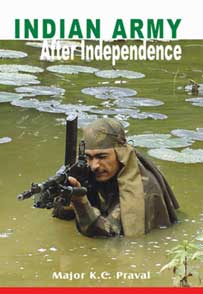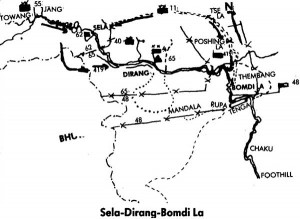“˜Chinese expectations that defeat would soften Indias attitude to the border question were belied by the reaction in India.
Towang had not been prepared for evacuation. The precipitate withdrawal created chaos. ‘Streaming down with the troops were pioneers, Assam Rifles personnel and hundreds of civilians, including lamas from the monastery’. The task of covering the withdrawal had been given to 4 Garhwal; thereafter, the battalion was to hold Jang, together with the Engineers already there. The battalion had only two jeeps in the way of transport, which meant marching manpack and destroying all that could not be so carried. The Sikhs too lost a good deal of equipment during the withdrawal. The Artillery were the worst sufferers; every field gun and mortar had to be abandoned. Sizeable stocks of supplies, clothing and ammunition had been built up at Towang during the preceding weeks. Most of these fell into Chinese hands.
By 24 October, the tactical Headquarters of 4 Division had been set up at Dirang Dzong, 64 kilometres South-East of Se La. 4 Garhwal had deployed one company on the bridge at Jang and the rest of the battalion (less a company) was occupying positions on the Jang-Se La axis. Towards evening, when the Chinese began to engage the Garhwalis holding the bridge, it was blown up and the battalion withdrew to occupy a screen position before Se La.
Important changes in command took place on 24 October. Lieutenant General Harbakhsh Singh took over 4 Corps and Niranjan Prasad was replaced by Major General A.S. Pathania. A well-decorated soldier, Pathania had won the Military Cross in the Second World War and the MVC after Independence. Before taking over 4 Division he had been the Director General of the National Cadet Corps.
A lull descended over NEFA after the Chinese occupied Towang. They needed a pause before embarking on the second phase of their operations. They had to improve their lines of communication, build up supply bases and regroup their force. They decided to use the pause for diplomatic overtures. On 24 October, while the dust of battle was still settling down over Towang, the Chinese Premier wrote to Nehru, suggesting a meeting. But the basis that he proposed was a formula that had been rejected by India earlier. Nehru turned down the proposal.
 ‘Chinese expectations that defeat would soften India’s attitude to the border question were belied by the reaction in India. After the initial shock wore off, Nehru found the whole country lined up solidly behind him, resolved to fight the invader’. The invasion had brought a new sense of unity among the people. Chinese efforts to follow up with an explanation of their proposals failed to impress India, though these had some propaganda value in international circles.Menon could not, however, escape severe criticism for the unpreparedness of the Army. Reluctantly, Nehru relieved him, and himself took over the Defence portfolio.19 The need of the moment forced him to ask friendly nations for military aid. The first loads of arms aid arrived from the United Kingdom. Early in November, American planes began to arrive in Calcutta with semi-automatic rifles, radio sets, mortars, recoilless guns and other items. Canada, France, Australia, New Zealand and many other countries also responded generously.
‘Chinese expectations that defeat would soften India’s attitude to the border question were belied by the reaction in India. After the initial shock wore off, Nehru found the whole country lined up solidly behind him, resolved to fight the invader’. The invasion had brought a new sense of unity among the people. Chinese efforts to follow up with an explanation of their proposals failed to impress India, though these had some propaganda value in international circles.Menon could not, however, escape severe criticism for the unpreparedness of the Army. Reluctantly, Nehru relieved him, and himself took over the Defence portfolio.19 The need of the moment forced him to ask friendly nations for military aid. The first loads of arms aid arrived from the United Kingdom. Early in November, American planes began to arrive in Calcutta with semi-automatic rifles, radio sets, mortars, recoilless guns and other items. Canada, France, Australia, New Zealand and many other countries also responded generously.
Click to buy: Indian Army After Independence
During the interlude, Kaul decided to return to 4 Corps; Harbakhsh Singh left exactly five days after he had taken over. Kaul had not yet fully recovered from his sickness but returned as staying back ‘would smack of either a punishment or evasive action’.20 After assuming command of 4 Division, Pathania made an estimate of his requirements for defending the Se La-Dirang Dzong-Bomdi La area and informed 4 Corps that he needed 17 Infantry battalions for the task.
Kauls request for new airfields and foreign aircraft with pilots was unrealistic. Other nation could not be expected to rush their air forces to India unless she had a prior arrangement or treaty for such aid.
For his part, Kaul asked for two more infantry divisions. To boost his logistics support, he suggested that friendly countries should be requested to provide aircraft with pilots and maintenance facilities. He also suggested the widening of the existing airfields and construction of new ones.
Kaul’s request for new airfields and foreign aircraft with pilots was unrealistic. Other nation could not be expected to rush their air forces to India unless she had a prior arrangement or treaty for such aid. In any case, the Chinese did not give India much time before commencing the second phase of the invasion. It must, however, be mentioned that at the time a belief had grown that the Chinese were not likely to continue their offensive in NEFA. One of the reasons adduced was that they were already well beyond the disputed Thag La region. Apparently, the Chinese maps which showed the boundary at the foothills of NEFA were forgotten. Another reason put forward was that they would not be able to complete the Bum La—Towang road before the winter set in. These may be some of the reasons for the slow build-up of 4 Corps during the lull.
Slowly, new units began to arrive in the theatre. They did not come properly equipped. Coming from various parts of India, they did not even bring their first-line transport. Except for pouch ammunition and personal arms, they hardly brought anything else. There was an extreme paucity of defence stores and digging tools; without them effective defence was not possible. The airlift made available to 4 Division was 50 tons a day against a requirement of 250 tons.
By the second week of November, 62 Brigade had established itself at Se La (see Fig.). It now had five infantry battalions under command. Three of them – 1 Sikh, 2 Sikh LI and 4 Sikh LI – were holding positions on Se La or features around the pass. The Garhwalis still held the screen position North-West of Se La which they had occupied after evacuating Jang.
Brigade Headquarters was South of Se La and the fifth battalion – 13 Dogra – was at Senge, further South, guarding the dropping zone. The brigade’s artillery element comprised three batteries of field guns (two from 5 Field Regiment, one from 6 Field Regiment), 2 (Derajat) Mountain Battery, 116 Heavy Mortar Battery and a troop of 34 Heavy Mortar Battery. Located near the Brigade Headquarters was 19 Field Company and 2 Sikh LI had a platoon of Mahar machine-gunners under command.The Headquarters of 65 Brigade was at Ewang, a short distance North of Headquarters 4 Division at Dirang Dzong. Of its two infantry battalions, 19 Maratha LI was deployed in and around Ewang and 4 Rajput was holding a bridge on the Senge-Dirang Dzong road with other companies widely dispersed. The artillery with the brigade consisted of the Headquarters of 6 Field Regiment, one of its batteries and a section of mountain guns. A platoon of 7 Mahar (machine guns) was also under the brigade.
Straightaway after the fall of Towang, they began work on it and before the second week of November was out, the road was more or less ready.
At Bomdi La, 48 Brigade was in position with three infantry battalions 5 Guards, 1 Sikh LI, 1 Madras. Besides a platoon of 7 Mahar machine-gunners, it had a battery from 6 Field Regiment, one mountain battery and two tanks from 7 Light Cavalry. This armoured regiment (less a Squadron) had moved from Varanasi in the last week of October. On arrival at Misamari it was ordered to send forward one squadron. of this squadron, one troop was to be deployed at Bomdi La, another (with Squadron Headquarters) at Dirang Dzong, and the third at Se La. Due to the bad road conditions and the steep climbs, the squadron made Bomdi La only on 5 November after losing two tanks and some men on the way. When the remaining tanks arrived at Dirang Dzong, it was discovered that the climb to Se La was beyond their capacity.
As they settled down in their new positions, the troops undertook a certain amount of aggressive patrolling. Morale was gradually building up. A party of Press reporters visited Se La in the second week of November and brought back a good impression of the troops. There was an air of optimism at the front and in the rest of the country. It was felt that the worst was over. The belief in the invincibility of Se La was reflected in the new name given to the operational plan: ‘Olympus’. A consignment of 7.62 semi-automatic rifles and 81-mm mortars had been received by 4 Division. These weapons were, however, not put into the hands of troops; possibly, their ammunition had not arrived. Most of the crates containing the new weapons later fell into Chinese hands, unopened.
The Chinese had catered for the building of the Bum La—Towang road before they began their second phase. Straightaway after the fall of Towang, they began work on it and before the second week of November was out, the road was more or less ready. Thereafter, they began to improve the Towang-Jang section; by the morning of 17 November, the bridge at Jang was in commission and the infiltration began.21
| Editor’s Pick |
In an appreciation, Kaul had vaguely referred to the likelihood of enveloping moves from the East and West of the main axis to outflank Se La. However, he took no steps to meet such a contingency. The Bomdi La-Se La sector had ten infantry battalions against the 17 which Pathania had asked for. But even with these meagre resources it should have been possible to form a mobile reserve. Kaul and Pathania, however, contented themselves with static defence, with many of the battalions being split up into companies to hold isolated hilltops.
Like the Japanese in Burma, the Chinese chose a very difficult route to outflank 4 Division from the East. They used the Bailey Trail. In 1913, Captain F.M. Bailey had accompanied the Survey team whose findings enabled McMahon to draw the boundary between India and Tibet, East of Bhutan. On their return journey from Tibet, Bailey and his party used the Tulung La-Tse La22-Poshing La-Thembang route. In his report, Bailey had described parts of the route as very bad. It was assumed by Pathania that it would not be possible for the Chinese to bring up a sizeable force using the Bailey Trail; a company was the maximum they could bring, he thought. In this assumption he was supported by Army Headquarters and the Intelligence Bureau. The lessons of the Burma Campaign were forgotten, as also the fact that nothing is too difficult for determined troops. In the event, the Chinese brought up about 1,500 of their troops by this route.





